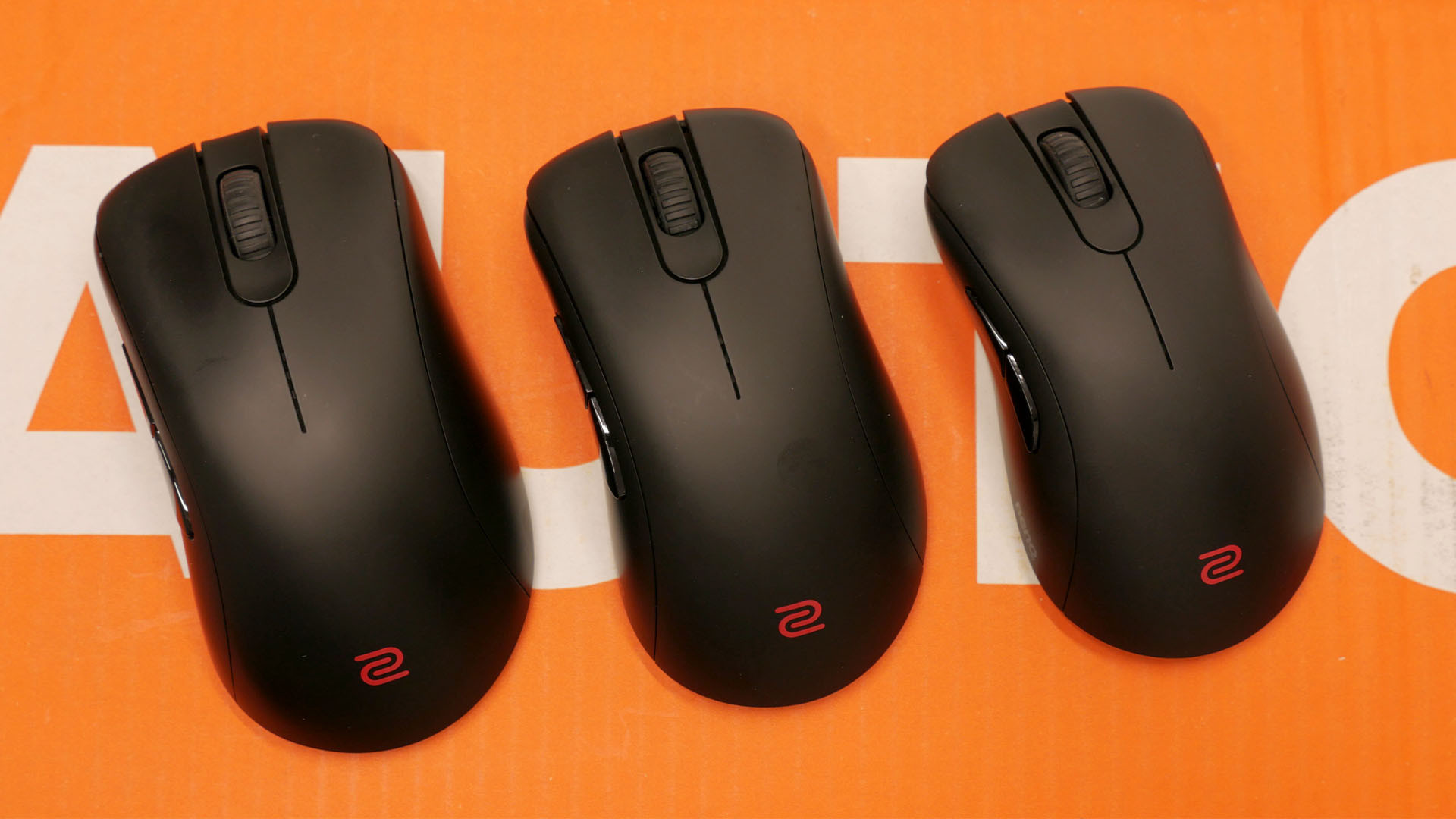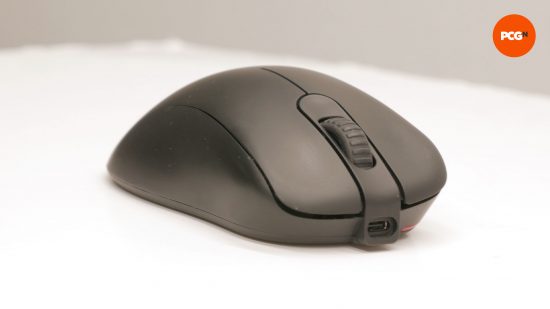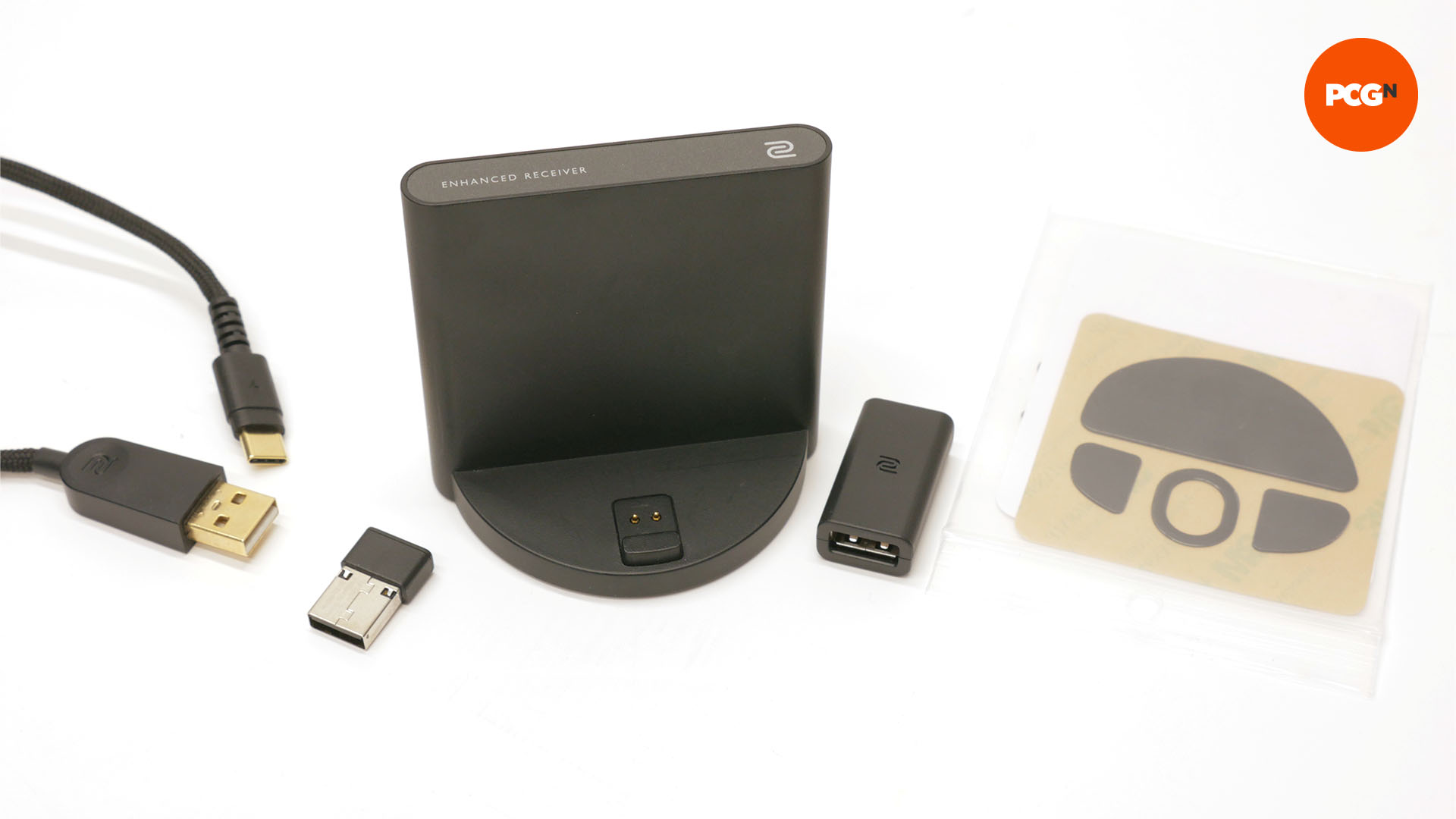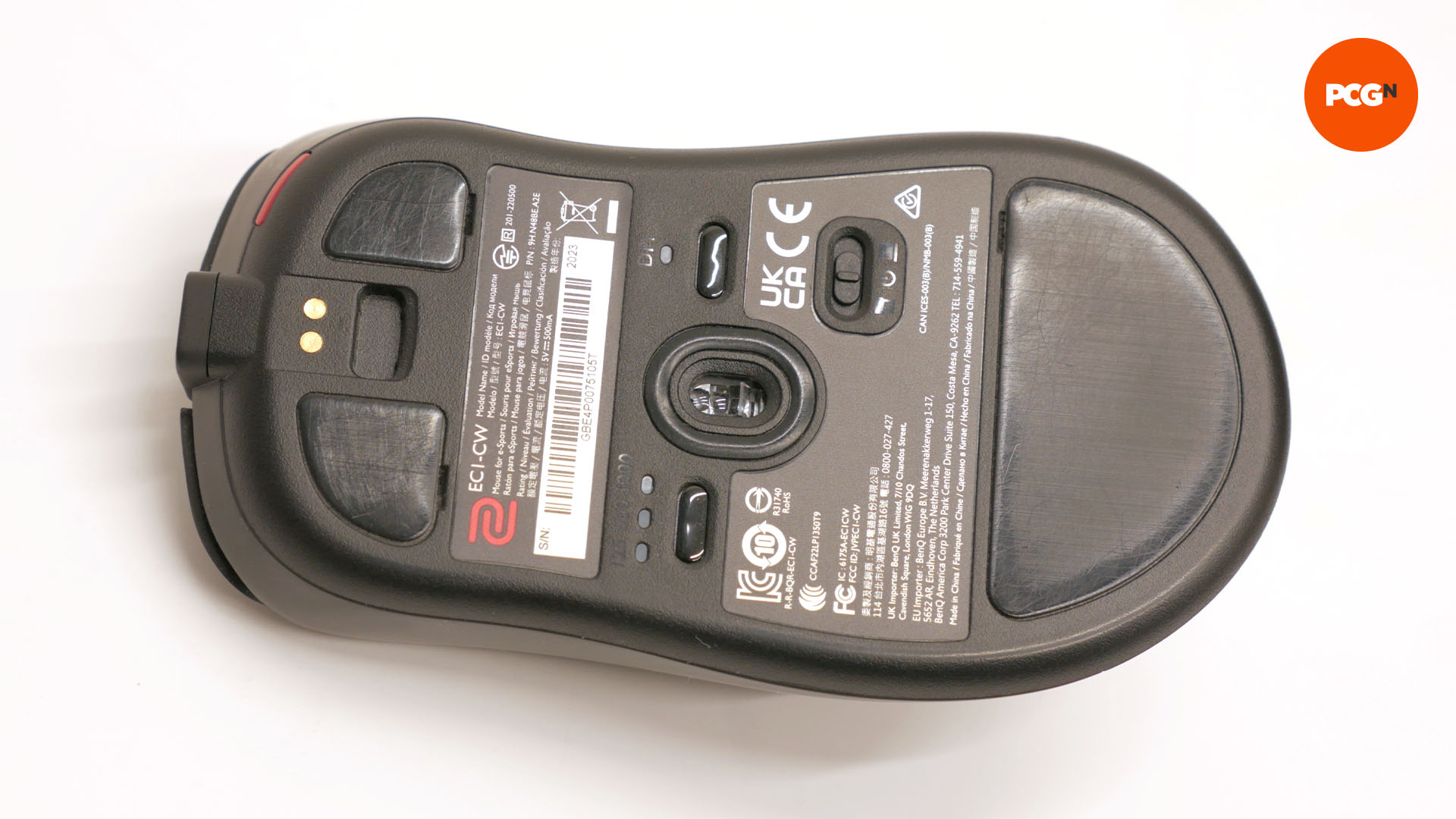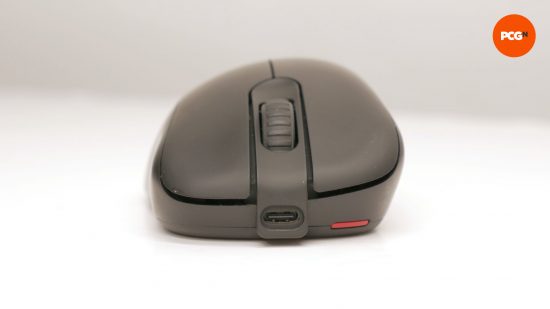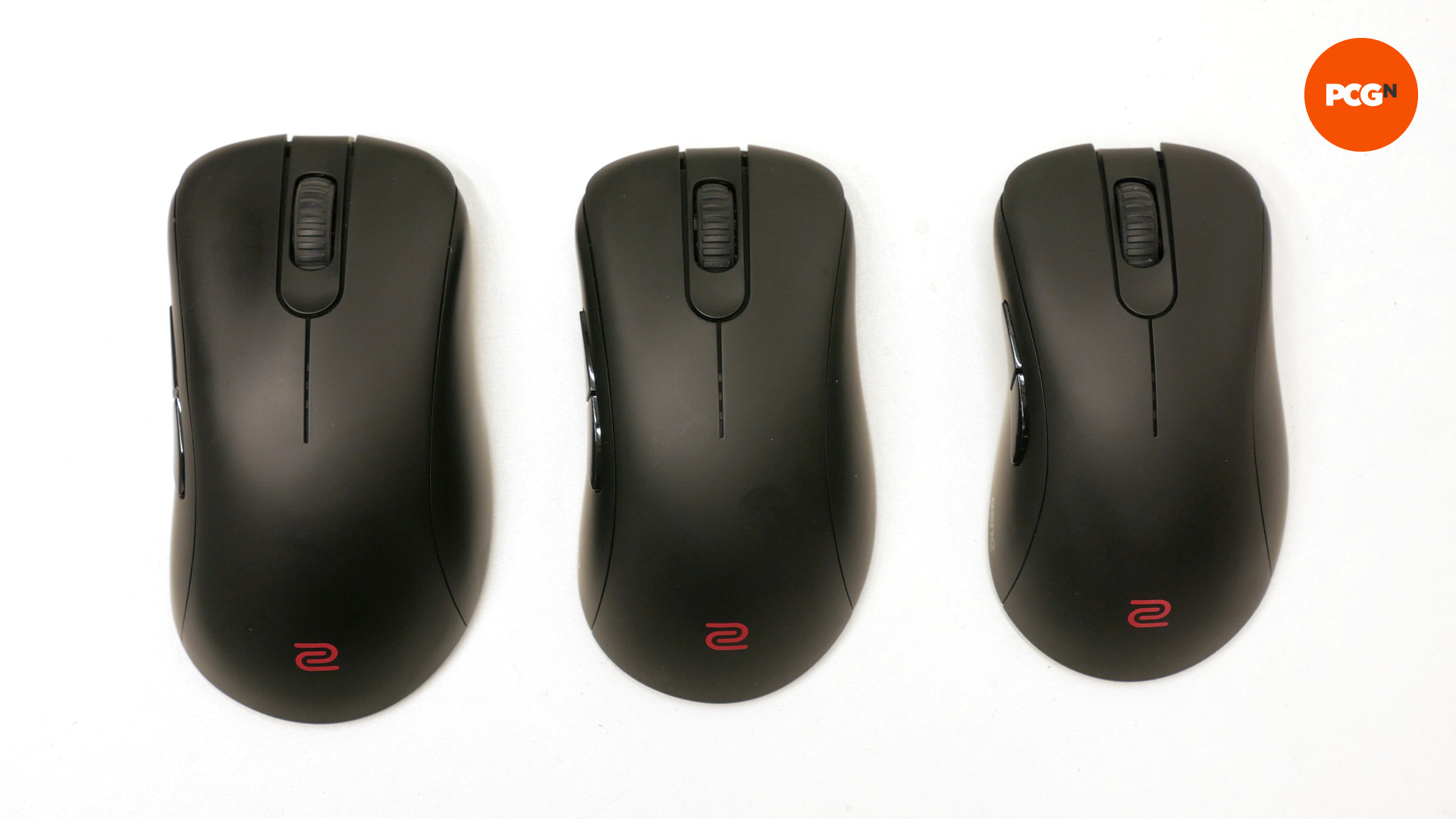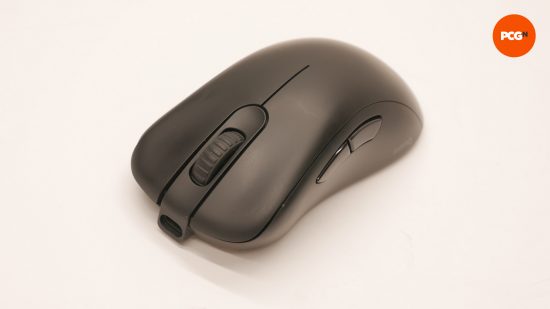Our Verdict
BenQ Zowie brings its esports gaming mouse excellence to the wireless mouse market, with a trio of mice that are comfortable, well built, and offer flawless performance. They’re best suited to palm grip users, though they can turn their hand to other grip styles. They’re not the lightest mice available, and they lack any RGB lighting, but they’re reliable tools of the trade, and the wireless receiver/charging dock is a really useful addition.
- Comfortable ergonomic shape in three sizes
- Excellent tracking performance
- Crisply defined buttons and scroll response
- No software required
- Decent value
- No software limits customization
- Dull design
- No RGB lighting
- Lacks extra buttons
- Could be lighter
The BenQ Zowie range of gaming peripherals has been a mainstay of elite esports gamers for years. Their focus on no-frills gaming features and top-tier performance has seen them maintain a steady appeal. Now the company’s back with an updated lineup that adds wireless connections to its beloved mice. Here we’re looking at all three sizes of the BenQ Zowie EC1-CW, EC2-CW, and EC3-CW, having previously only checked out the middle-sized EC2-CW.
All three of BenQ Zowie‘s new mice deliver excellent performance, making them prime candidates for the best esports titles on our best gaming mouse guide, whatever your hand size and preference. Some users will prefer a different overall shape, but the ergonomic design here has plenty of appeal.
BenQ Zowie EC1-CW specs
| Zowie EC1-CW /EC2-CW / EC3-CW specs | |
| Sensor | PixArt PWM 3370 |
| Buttons | 5 |
| DPI | 400/800/1,600/3,200 |
| Weight | 79g / 77g / 76g |
| Connections |
Wireless: (USB-A dongle and USB-C charging dock/wireless dongle) Wired: (USB-C port on front of mouse) |
BenQ EC1-CW features
The BenQ EC1-CW and its pair of slightly smaller siblings, the Ec2-CW and CW3-CW, are not gaming mice that sport flashy, big-number, high-end features for the sake of it. However, under their hoods they still have very capable sensors, as well as the core features that competitive-focused gamers will value.
The biggest change, as compared to the previous non-CW versions of these mice, is that the new models are wireless. They ship with both a small USB-A dongle (including a USB-C to USB-A adapter) and a much larger charging dock/wireless receiver, the latter of which has a USB-C port. This gives you the option of having a more portable receiver for use when traveling, or having a more convenient charging dock when you’re at home.
The mouse can also be connected to your PC and charged via a USB-C port on its front, so you have plenty of connection options. In the box you get a 2m (6.6ft) braided cable that’s of a Goldilocks weight; it’s not as stiff as older style braided cables, but not quite as thin and flimsy as the wires on some modern mice.
For buttons, you get just five main ones, consisting of left, right, and middle-click (scroll wheel press) buttons on the top, and two side buttons for use with your thumb. There’s no top DPI button, or any other extras that are immediately accessible. For many competitive FPS gamers, this is the preferred setup, as extra buttons can often just get in the way during the heat of battle. However, if you do like to have a few more easily accessible options, this isn’t the mouse for you.
Not that the BenQ EC1-CW doesn’t have a DPI button. Flip over the mouse and you’ll find a DPI button that cycles through four preset levels – 400 / 800 / 1,600 / 3,200. Another button here lets you cycle through the three polling rate settings of 125Hz, 500Hz, and 1,000Hz too.
Crucially, though, BenQ doesn’t provide any means of altering these preset options. So, if you only want to switch between two DPI levels – a setup I generally favor – you’re out of luck and instead have to memorize which color from the LED above the DPI button corresponds to the settings you prefer. The same is also true for the polling rate, though you generally won’t need to change this setting again once it’s set to your preferred rate.
Through combinations of button presses and powering off and on the mouse, you can also adjust lift off distance and click response time (to reduce the debounce delay) but that’s your lot for adjustability.
Also on the underside is a switch for selecting which of the two wireless dongles to connect, or for just turning off the mouse. Unlike many modern wireless mice, such as the Razer Viper V3 Hyperspeed, this mouse can’t also connect via Bluetooth.
Meanwhile, the scroll wheel on this mouse has quite an aggressively notched outer rubber surface, and equally aggressive detents as you rotate it. BenQ sees gamers using the scroll wheel for precise single-notch actions, such as precisely changing a weapon mid-fight, than more freewheeling, multi-notch movements.
BenQ EC1-CW design
The core shape of the ECx-CW trio is that of a fairly classic ‘ergonomic’ gaming mouse. What does that mean? Well, instead of the symmetrical designs favored by the likes of the Logitech G Pro Superlight X, Razer Cobra Pro, or BenQ’s many other mouse shapes, ergonomic designs instead employ a lopsided shape where the thumb side rises a little higher than the little finger side, and the latter has a smoother, more convex outer edge than the flatter or inward-dipping sides of symmetrical mice.
The result, which is reflected here, is a mouse that feels a little more comfortable if you somewhat lazily drape your hand over it, assuming you’re right-handed – there’s no left-handed option. This also makes for a mouse that’s well suited to using a palm grip where your hand is resting on and supported by the mouse. It can also work somewhat well with a claw grip, though the back isn’t particularly grippy.
These mice can also work with a fingertip grip, but they’re not particularly well optimized for it, especially if you only use your little finger to grip the right edge, rather than your ring and little finger. You could alternatively opt for the smaller Ec2 or EC3 for fingertip grip, even if you otherwise have reasonably large hands. I found I could play reasonably comfortably on the EC1-CW with a fingertip grip, but found a little more freedom of under-palm movement with the EC3-CW.
One factor that also plays a key role in the comfort/size/grip equation of these mice is their weight. This new range is much lighter than the older wired versions of the ECx shape, but they’re still not particularly light by modern standards. The larger EC1-CW weighs in at 79g (80g according to our scales), while the smaller Ec3-CW is 76g (matched by our scales), which compares to just 60g for the Corsair M75 Air, for instance.
With their slightly heavier weight than some other mice, I found these mice weren’t all that well suited to my preferred fingertip grip, as my fingers could slide up the right side on occasion. These mice are a touch back-heavy when used in this style too – you really do need two fingers on the side to reliably lift them up and down from the mouse mat.
As for the look of this mouse. Well, it’s all business. It’s plain black with a matt finish that has a tendency to show off fingerprints and wears to a shine quite quickly. Meanwhile, there’s no RGB lighting here at all, with just a painted red Zowie logo on the rear of the mouse and a single white LED shining through the split between the left and right buttons – this light indicates charging (solid) and low power (blinking) status.
BenQ EC1-CW performance
When it comes to gaming performance, mouse shape preference, and grip style aside, the EC1-CW can’t be faulted. Its PixArt PWM 3380 sensor doesn’t claim Ludicruos maximum DPI numbers as high as the Razer Viper V3 Hyperspeed’s 30,000 DPI, but it can hit 19K internally (downscaled to the provided DPI levels) and reach 400 inches per second movement speed, along with 50g of acceleration.
As a result, this mouse performed flawlessly in our tests in terms of keeping up with extreme movements. It also showed no signs of unreported acceleration or any other drops in accuracy, keeping in line with accurate tracing in Photoshop at low DPI, or larger cross-desktop movements at high DPI.
Fitting in with the slightly rugged tool-of-the-trade feel of these mice, the buttons have a very defined click, with quite a low, hollow kind of sound. I found this provided a reassuring sense of control. The switches used by the likes of Logitech and Razer have a slightly lighter feel that can sometimes err on feeling too easy to press. It’s a similar story with the scroll wheel detents and middle click – there’s no mistaking when you’ve moved or pressed the wheel here.
The only real downside regarding performance is again the lack of any extra buttons, if you require them, and again preferences on shape and weight. The Cherry Xtrfy MZ1 is much more of a fingertip grip FPS tool than this mouse, but the BenQ gives you a more comfortable mouse for day-to-day use, or for palm grip gaming use.
BenQ EC1-CW battery life
BenQ pins the EC1-CW’s battery life at 70 hours, which largely tallies with my experience. After a couple of days of off-dock use the battery indicator light will start blinking. Just a few seconds of charging will get you many minutes of use, and a ten-minute charge will see the mouse last many more hours.
All told, the EC1-CW is in line with other rechargeable wireless gaming mice for battery life, although the Razer Viper V3 Hyperspeed‘s replaceable AA battery means it can last far longer, if you don’t mind potentially swapping batteries mid-game.
BenQ EC1-CW price
The EC1-CW price of $120 certainly isn’t cheap, especially for a mouse that doesn’t include any RGB lighting or extra top buttons. However, you do get the extra underside buttons, the charging dock/receiver, replacement glide pads/feet, and the standard USB-A wireless dongle. That still makes for a premium mouse, but BenQ mice have generally proven to be reliable workhorses so we’d expect the EC1-CW to hold up for a long time too.
BenQ EC1-CW review conclusion
There’s a heck of a lot to like about the EC1-CW, EC2-CW, and EC3-CW. Their shape is comfortable, performance is excellent, and build quality is good too. If you’re a fan of ergonomic-shaped mice, or prefer a palm grip, these are excellent choices.
They’re less suited to other grip styles for gaming, though, and the lack of RGB and other more showy extras dents the value on offer here. The lack of software customization can be limiting too. The extra wireless/charging dock helps balance the books a little, but this is still quite an expensive mouse considering its fundamentally basic design.
BenQ EC1-CW alternatives
Razer Deathadder V3 Pro
The Deathadder is Razer’s classic ergonomic mouse shape, and it offers a similar feel to the Ec1-CW but in a slightly slicker-looking form. The Deathadder V3 Pro is the latest version, which is much lighter than the BenQ at just 64g and much more programmable, but it’s also more expensive, costing $140.
Glorious Model D2 Pro
Another wireless ergonomic mouse option is the Glorious Model D2 Pro. This mouse offers ultrafast 8kHz polling – for an extra cost – but otherwise has a similar no-frills approach to the BenQ, albeit with an added top DPI button and software programmability. Plus it’s cheaper at just $80, following extensive price drops from its original $130 MSRP.

